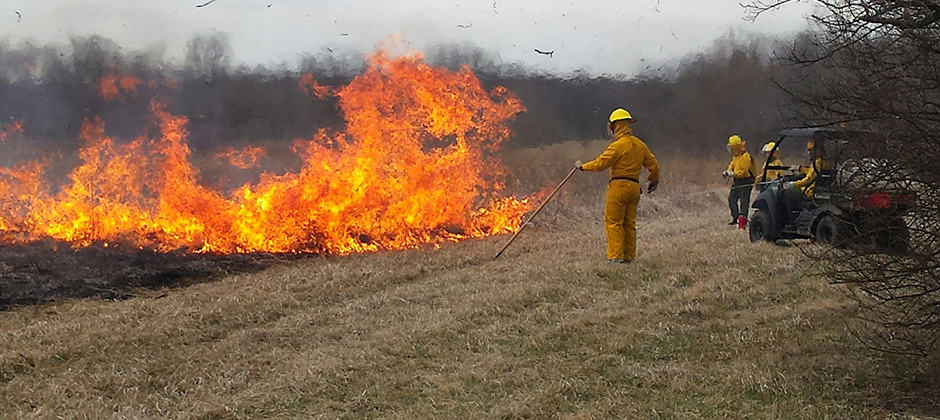Share this article
Will pandemic have lingering impacts on state agencies?
COVID-19 has affected everyone, and wildlifers are no exception. In this series, TWS is looking at challenges facing the profession due to the pandemic.
For Angie McIntire, like so many other Americans, the outbreak of the novel coronavirus has meant working from home and holding meetings with colleagues online.
“Like everyone else, there’s been an upsurge in Zoom meetings,” said McIntire, bat project coordinator with the Arizona Game and Fish Department. “I miss my co-workers in my office.”
The ramifications of the pandemic are affecting how states do business across the country. In state wildlife agencies, many are wondering how COVID-19 will affect their funding and their ability to continue their management and conservation work.
The economic fallout from COVID-19 is affecting all state budgets. “What that’s doing to us right now is creating hiring freezes across the board for state agencies,” said Nelson Lafon, the Forest Wildlife Program Manager at the Virginia Department of Game & Inland Fisheries.
State agencies rely on sales of both resident and non-resident hunting and fishing licenses and often other sales tax dollars. That has agencies worried about how state-at-home orders, travel restrictions and business closures will impact their budgets, particularly if a second wave of the pandemic resurges amid fall hunting seasons.
“We have no way to predict if people are going to feel safe traveling in the fall or not,” said Kelly Hepler, president of the Association of Fish and Wildlife Agencies.
Under the Pittman Robertson Act, 75% of funding for approved conservation projects comes from federal excise taxes on firearms and ammunitions sales. Those dollars are matched with a 25% contribution from state fish and game agencies. Hepler said he’s hoping that, in light of the economic strain from COVID-19 and states’ ability to come up with matching funds, lawmakers will change that ratio to allow federal dollars to pay 90% of conservation projects.
Those federal dollars don’t seem to be lacking. Gun stores across the country are reporting boosts in sales amid the pandemic. Online ammunitions retailer ammo.com reported a 792% increase in revenue and a 574% increase in transactions between Feb. 23 and March 31.
“Sometimes an election does this, or sometimes it’s from people being stressed like right now,” Hepler said of the increased sales. “We would love to put that money back on the ground to improve those facilities people are going to now. Hopefully, we can take advantage of it.”
Outreach to the public has also been difficult during this time of reduced social contact. Lafon said his agency’s work with private landowners to reduce human-wildlife conflicts or develop habitat management plans has been curtailed. “We have to deal with correspondence over e-mail or phone, and we COVID-19 precautions are also delaying other management activities, like prescribed fires, which are important in encouraging the growth of new vegetation that many species rely on.
“March and April are the biggest months for doing prescribed fire, not only on public lands but also on private lands,” said Bill Vodehnall, a wildlife biologist with the Nebraska Game and Parks Commission. With state guidance limiting gatherings to 10 people, prescribe fires, which require larger crews, can’t be carried out, Vodehnal said. Distancing guidelines make it even more difficult, he said, and agencies are trying to avoid hazardous activities that could send crew members to the hospital.
“A backlog of projects and planning ahead will cause a little more pressure next year,” he said.
Some states are expecting declines in hunter numbers after restricting hunting seasons. Washington State, for example, closed access to some public lands and canceled a youth turkey hunt and spring bear hunt. Alaska, which relies on non-resident fishing permits, is seeing a 50% drop in fishing dollars, Hepler said.
Meanwhile, much of the public seems to be turning to the great outdoors to escape the blues of lockdown. In Virginia, anecdotes and some harvest data suggest hunting and fishing are up. Arkansas waived its fishing license requirements for the last week of March to encourage people to get outdoors. Pennsylvania opened its trout season two weeks early. Oregon extended its tag sales deadline to encourage people to get outside.
“There’s increased participation out there in the woods,” Lafon said. “There could be less competition for other sports. It’s one of the only games in town.”
That could offer a silver lining to the tragedy, said Adam Janke, an assistant professor and extension wildlife specialist at Iowa State University. The timing of the virus outbreak in North America has at least afforded people opportunities to get outside amid budding trees and active wildlife as an escape from lockdown.
“We’re trying to see a role for wildlife biologists in all of this,” he said. “Perhaps that’s to help bring people into nature.”
Hepler agrees. He is focusing on how to keep staff and the public safe, which mean keeping people outside in nature, but maintaining social distancing.
“We want to get people outside. We want to get them fishing and hunting and to do that in away reduces contact. We’re social creatures by nature, so we’re figuring out ways to do that,” he said. “Once this virus will pass sooner or later, how do we keep these people outside come back outside? That’s an opportunity we’re really interested.”
Header Image: Park staff and Ohio Division of Wildlife personnel conducted prescribed burns at Caesar Creek Lake, Waynesville, Ohio in this 2016 photo. Credit: Kimberly Baker/U.S. Army Corps of Engineers








